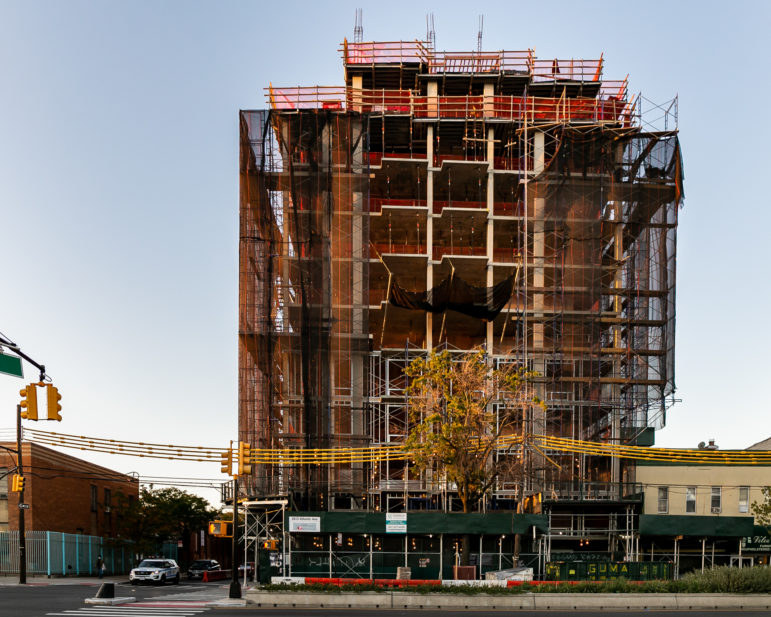“Invoking environmental concerns to block construction is a classic page in the NIMBY playbook, but when suburbanites push back against dense, transit-oriented housing, they are not just hurting the people who urgently need housing in our city—they are hurting the climate for future generations of New Yorkers, too.”

Adi Talwar
Construction in downtown Brooklyn in November 2021.Suburbanites say new housing will hurt the environment. They couldn’t be more wrong.
With New York in the throes of a dire housing shortage, Gov. Kathy Hochul has unveiled a plan to get 800,000 new homes built across the state over the next decade. The policy garnered instant resistance from the usual suspects: Suburbanites in places like Nassau and Suffolk counties. One reason to oppose the plan, they argue, is that new housing in the suburbs will damage the environment.
READ MORE: NYC’s Homeless Shelter Population Ballooned in 2022. How Will Leaders Address the Crisis This Year?
This opposition is misguided. In fact, Hochul’s plan is good for the climate. Invoking environmental concerns to block construction is a classic page in the NIMBY playbook, but when suburbanites push back against dense, transit-oriented housing, they are not just hurting the people who urgently need housing in our city—they are hurting the climate for future generations of New Yorkers, too.
Hochul’s plan would require localities served by the MTA to increase their housing stock by 3 percent over the next three years. To meet this target, the plan would rework the region’s zoning laws to automatically allow 50 housing units per acre in all areas within a half-mile of a train station. Should the plan pass, developers would be allowed to build small apartments near transit hubs without seeking special zoning approval from local governments.
Dense housing, which this rezoning would encourage, is good for the environment. Households living in apartments with five or more units use about half as much energy as those living in detached houses, according to the U.S. Energy Information Administration, and the effect is even more pronounced in newly constructed apartment buildings. Limiting emissions from homes is important because residential buildings are a huge driver of U.S. energy consumption—20 percent of greenhouse gas emissions nationwide come from residential buildings.
Additionally, constructing housing near public transportation limits harmful emissions. In 2016, 30 percent of the city’s emissions came from transportation, and 96 percent of transportation emissions came from on-road vehicles, compared to just 3 percent from trains. Getting people out of cars and onto buses and trains, especially if they have long commutes from the suburbs, is vital. Environmental groups like the New York League of Conservation Voters praised Hochul’s plan for this reason, writing that the plan would create “dense, walkable, transit-oriented development, which will reduce emissions.”
Hochul’s plan would also expedite the environmental review process that new construction projects must pass before they can break ground. Counterintuitively, streamlining such review processes can be important for building greener infrastructure. In California, environmental review laws have been used to slow or halt the construction of new housing, solar farms, and public transportation. New York must avoid similar delays as it transforms into a more environmentally friendly city.
Hochul’s proposal isn’t a silver bullet for the housing crisis or the environment. Housing advocates are still calling for the establishment of good-cause eviction protections and increased investment in public housing. The government must take other steps to clean up the climate, too, like reducing emissions coming from existing buildings. But even if there’s work to be done elsewhere, up-zoning the suburbs is a step in the right direction.
State legislators will decide if the plan takes hold in the coming months, as part of the annual budget-setting process. Last month, Nassau County executive Bruce Blakeman voiced a typical opposition to Hochul’s proposal, saying increasing density would “jeopardize the suburban character” of his region. Aesthetic concerns like Blakeman’s must not prevent New York from confronting the more serious issues it faces.
We have an opportunity to make progress on both the housing crisis and the climate crisis in one fell swoop. Building dense housing near public transportation not only gives New Yorkers better places to live, but helps ensure a cleaner climate for the city’s next generation of residents.
Ben Hitchcock is a researcher and master’s student at NYU’s Wagner Graduate School of Public Service.









One thought on “Opinion: NIMBYs Are Wrong—New Housing is Good for NY’s Climate Goals”
Mr. Hitchcock does not understand that Nassau and Suffolk Counties are not the City of New York. This is the arrogance of NYC urbanites who simply can’t understand that people choose to live in suburbs because they are suburbs. In fact, “suburbanites” are most often residents that have fled NYC to seek a better life for their families. If the “city’s next generation of residents” wants increased density, this suburbanite says there are plenty of neighborhoods in the 5 boroughs that developers can plunder. For the environment of course.